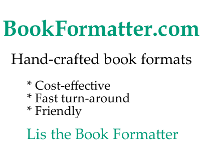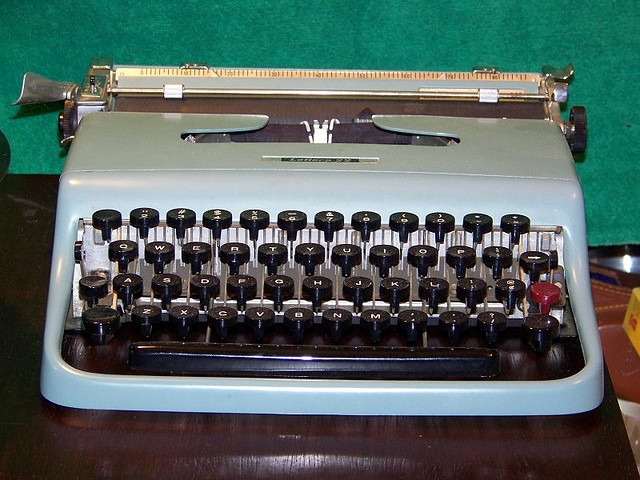Wow it’s been a while, about a month, but finally my newest website is live: BookFormatter.com (yes I was surprised that such a grammatical, 2-word dot com was still available to).
The thing is – it’s not just a website, it’s actually a business!
Hanging out on a writers’ forums I see an awful lot of authors who are not sure that they are, or if they want to be in business. I have a lot of sympathy for the ones who say “I’m not in business I just want to write books”. I used to say something similar – my version was:
I don’t want an online business. I just want to rank websites and make money from affiliate sales and advertising. I’m just an Internet Marketer, not a business-owner.
Well the Google changes last year put pay to that. I figure that, although I could probably win in the short-term, medium-term the 1000’s of PhD’s that Google employs were probably going to win .
So I turned to books, which is exciting, but frankly I’m not building my backlist fast enough to make a decent wage. I’m not giving up on that, but I needed a more short-term cash boost. So BookFormatter was born.
Service Businesses Online
I’ve thought for a while that my Kindle formatting services page needed expanding. For a start I don’t just format for Kindle I also do ePubs for other eReaders and pdfs for print-on-demand.
Plus a separate site meant the I could focus on getting all the words in the right order, with commas, and all the other stuff the writerly people seem to worry about. (If I’ve missed some on BookFormatter.com feel free to email: lis(at)LisSowerbutts.com)
It took a while, partly because people kept on contacting me to help format their books! It’s taken me about a month to get the site live, along the way I’ve thought rather a lot about the process of launching a service business online.
I’m actually gone about this with some thought, and even, hold on to your keyboards, a bit of a plan. So business planning by Lis 101 – who’d have thought?
Why?
Well that’s easy – I need the cash flow. Books make money, but it takes a while, and is uncertain. Most books I can format within 24 hours and the clients pay 50% upfront and 50% on acceptance – the most I’ve had to wait for payment is about 24 hours after I sent the invoice. That’s a good cash flow business.
It also has the potential to bring in more NZ$ – the US$ exchange rate is continuing to hurt like hell – my expenses are in NZ$.
Then I discovered another reason – I rather liked doing it. I actually liked the interaction, the sheer novelty of starting with a book put together in a way I’d never have done myself, and making it work. I’ve always liked troubleshooting too and fixing problems as they come up. The interaction with clients was fun. It’s possible I’ve been in the back bedroom too long.
Defining An Offering For Sale
I must admit I’ve never been a huge fan of having a service business online. Indeed briefly I did offer small-business website SEO and basic websites. I struggled with it though, because it’s a very open-ended offering. It’s hard to know when you are done, you need to be very clear what you are quoting for and how you and the client will know when the job is finished. I got burnt rather badly by a client who could never quite decide which pixel went where (I’m not exaggerating) – I walked away when I realised I was living the famous Oatmeal Cartoon.
This time around I’ve learned a lot. Basically book formatting is something I like doing, and because of a very weird background I have in obscure programming languages (awk, grep, sed) and old-style software (vi, DisplayWrite) I’m pretty fast at it. I’ve also narrowed down my audience to several groups. I think knowing who your audience is helpful, because then you know how to find them.
If you are going to make a service business work need two things; demand, obviously, but also the ability to perform the service quicker, better, more-effectively and at a better quality than the average Joe.
Pricing
Pricing – that’s the hardest bit still I think. At least I’ve stopped apologising for asking for money LOL. I’m lucky with book formatting there are a bunch of competitors, listed right on Kindle Publishing’s help page. I checked them out. They were pretty expensive. Clearly the bigger boys were carrying expenses that I didn’t have (I suspect they are outsourcing to a third-world country and having to manage both the client and the worker). A lot of the pricing was just silly – quoting in hours when a client had no idea how many hours a job would take or in pages for an eBook. I also checked those advertising in places like kboards.com. Some of those were very low.
In the end I kept records of how long jobs took, worked out my required hourly rate, and came up with some indicative prices. I fell between the low and high-end of existing competitors – so that seemed like a good place to be. If I get overwhelmed with demand, I’ll put prices up.
Marketing
Having worked out WHAT you’re offering, I started in a small way and when people approached me, I tried to remember to ask them how they found out about me. After a while I saw some patterns.
First – I had an abject failure by trying to market to my friends over at da Pond – most of them were fairly tech savvy, were writing non-fiction, and didn’t have a lot, emotionally or financially, invested in their books. Cheap as possible was what they wanted to spend, and most had figured out how to do their own formatting which was “good enough”.
Instead the people who actually found me and hired me were:
- authors who don’t have time and/or the inclination to format their books themselves;
- generally weren’t online in a huge way;
- normally had full-time, well-paying jobs.
But now it’s got more specific – I’m starting to see a pattern. I’m primarily attracting:
- those who have bought my Kindle formatting book, understood the process, and decided they’d like to outsource (they make awesome clients because they understand what I’m offering them);
- panic-stricken author’s who have just got a warning from Amazon that their Kindle book has problems. Because of my time zone I can often fix this faster than they’d believe;
- authors who have a book published several years ago on paper, but have put off getting the eBook out as it was too hard.
Advertising
Having discovered the audience you then think about where they hang out, or how they might find me. The readers of my formatting book are easy – there’s sign-up at the back for the sample files in the book.
The panic-stricken seem to find me via Google from what I can work out. That’s the easy bit of advertising – the keywords shouldn’t be hard to rank for.
The third group, existing authors, I’m thinking about. It may be more about personal contacts and world-of-mouth among not so much writer groups, but those that have a story to share with fans (think those with causes or messages to share).
From the Great Minds Think Alike Camp
Completely by coincidence within days of my launch
- Belinda launched RedSwallowDesign, for book covers and all things design; and
- Loreecee launched eBookSalon.net for promoting your free days
Basically a new author who wanted to self-publish but wanted to outsource as much as possible – between the three of us I’d say your entry price is around $200 (budget cover $100, formatting $70, free book promotion $35) . Compared to the many, many thousands most self-publishing “companies” charge….


